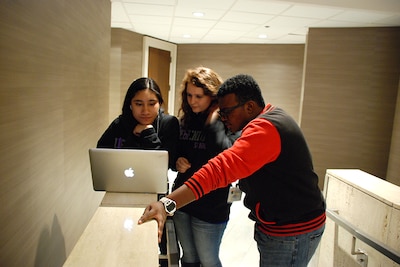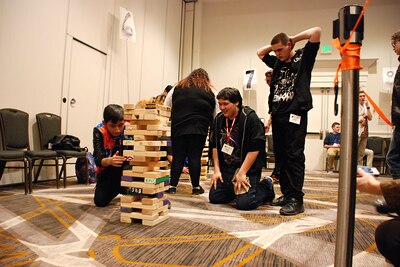The teenagers from Thornton hop around the giant wooden blocks stacked in three-foot towers, trying to figure out which piece can be removed without it all crumbling down.
The team from Academy High School has come here, to an annual tech competition, to prove they can stack up against students from places of privilege, from schools that always make the best-of lists.
The Giant Jenga tournament is their best chance.
If they can perform well at the Technology Student Association conference, maybe even prevail, it could prove to be an encouraging sign that their school’s four-year investment in STEM education has paid off.
STEM, an integrated, interdisciplinary approach to learning that exposes students to hands-on experiences, has become a buzzword in public education. The emphasis on science, technology, engineering and math has been embraced by government leaders, prominent philanthropists and business leaders eager to groom employees for today’s digital economy.
Many of these efforts — including the one at Academy — are meant to provide opportunities to Latino and low-income students who face barriers to academic and economic success.
The technology conference staged at a Denver Tech Center hotel is an opportunity to put their STEM skills to the test in a variety of competitions — from debates to underwater car races.
“It’s overwhelming,” said Paolo Domenico, an Academy sophomore. “There are like 1,600 kids here. They look like they’re more prepared.”
• • •
Josh Hirsch, a trained social studies and English teacher, joined the staff at Academy High as the school was undergoing a dramatic transformation.
STEM in Colorado | A Chalkbeat special report
PART 1: Little access to STEM education
PART 2: St. Vrain goes all in on STEM
PART 3: What the heck is STEM?
PART 4: A scrappy STEM school with something to prove
FIRST PERSON: How my STEM education is going to help me get clean drinking water in Ethiopia
HOW I TEACH STEM: An award-winning science teacher shares her classroom practices.
HOW I TEACH STEM: An award winning fourth-grade teacher shares her classroom practices.
The Gay & Lesbian Fund for Colorado provided financial support for this series.
“The plan was never to be a full-time technology teacher,” said Hirsch, sponsor of the Academy High team competing in the tech event.
About a decade ago, Mapleton Public Schools dissolved its single comprehensive high school into multiple smaller schools. Schools began adopting specialized programs, including an International Baccalaureate program, an early college and an expeditionary learning school.
Academy was the last school to choose a path — in 2012 — and that’s when Hirsch arrived.
District and school leadership had a vision to create a robust STEM program that would engage students and provide them the skills to choose careers from computer coding to nursing.
Hirsch, who had a budding interest in technology, quickly immersed himself in all things STEM. He even taught himself the basics of coding.
“It became a natural fit,” he said, later adding that one of many so-called “soft skills” a good STEM student must master is adaptability. “You have to stay relevant.”
Today, he teaches a wide range of technology skills — everything from the basics of word processing to how to build apps. It changes each year based on the level of experience of his students and their own areas of interest.
But adopting a STEM model at Academy has not been without growing pains.
Selena Aguiniga, a senior who competed at the tech conference last winter and graduated in the spring, said her classes experienced plenty of false starts.
“Teachers were confused sometimes,” she said. “But we were all able to problem-solve.”
Still, the school is hard-pressed to say the shift to STEM has paid off academically.
There’s no data proving that an increased focus on science or math has made a difference for students. The school’s ACT math score rose modestly from 17.6 in 2011 to 18.1 in 2016. And its ACT science score has fluctuated only slightly, ending at 18.8 in 2016. Both scores are about 2 points below the state average.
The school’s graduation rate — a data point other STEM schools often point to as a sign of strength — is down 9 percentage points since 2011.
“I would love to see STEM be a silver bullet,” Hirsch said. “But it’s still early in the process to know if this is going to make the difference. But we have to keep trying. What else are we going to do?”
• • •
The Academy High team started the technology contests from behind.
The team did not complete a video game ahead of the competition, so they had nothing to enter.

“It was a heavy workload,” said Carlos Cano, then a junior. “We weren’t used to the technology.”
The team began meeting five months before the conference to develop the game. It was supposed to be gory and involve the player attempting to escape an asylum. But it proved difficult to keep everyone on task, Cano said.
“It was kind of a disappointment, but at least we tried,” he said, adding that one of the core philosophies of STEM is that it’s OK to fail.
Cano knows something about trying. While the “S” in STEM has come easy for him, the “M” has not. And that’s put him behind in achieving his goals of building buildings.
“People say I won’t pass because I don’t know math,” he said.
But he’s been spending more time using an online resource to teach himself. And he has aspirations of starting at a local community college before transferring to a university.
At the tech competition, Cano looks around the hotel lobby, filled with mostly white teenage boys sporting zits and facial hair for the first time. He’s noticeably one of a few students with a darker complexion. Several of his teammates are white, too.
“We’re completely different people,” he said, referring to his white peers. “But we’re all friends. Race doesn’t matter.”
But Cano isn’t oblivious to the financial disadvantage he faces.
“We have to get scholarships to go to college,” he said.
• • •
After all the underwater car racing and indoor plane flying finishes for the day, it’s time for the most cherished contest at the tech conference: Giant Jenga.

Though it seems like the activity is just for fun, Jenga draws on STEM skills, too. It requires teamwork and some engineering know-how. It also somewhat levels the playing field. Unlike other competitions that require advance preparation, each team starts at the same place.
This provides a shot at redemption for Academy High, still stinging from not being able to enter a video game.
By now, most of the teenage competitors have traded their slacks and dress shirts for jeans and hoodies. Some teams have the names of their schools embroidered on their sweaters.
Academy puts together three teams of two for the tournament. Some schools have as many as four teams of four. The competition pits different teams against each other, with the winners advancing to the next round until only two teams remain.
Hundreds of teenage boys, a few dozen girls, and their teachers and parents cram into a small hotel conference room as the teams square off
“It’s good this is such a laid-back event,” Ty Dillon, one of Academy’s Jenga players, said sarcastically.
In truth, it is nail-biting.
While players move stealthily around the wooden towers — some on their knees — blocks elsewhere in the room crash down like thunder.
Organizers of the events yell out the next rounds’ participants.
Round after round, Academy beats teams from some of the state’s most respected public schools, including Cherokee Trail from the Cherry Creek School District, Ralston Valley from Jeffco Public Schools and Castle View from Douglas County.
At one point, a losing team congratulates the Academy team and suggests they improved since last year. That brings a smile to the face of Domenico, the sophomore who felt unprepared, because in truth, this was their first Jenga tournament and they were playing against and winning the respect of seasoned veterans.
Academy triumphed over numerous teams. But the scrappy students with something to prove fell just short of the Jenga trophy they sought in the semifinals.
• • •
Not all was lost.
Aguiniga, the senior who started with the STEM program four years ago, and her debate partner Breanna Allen came in second place in their division. Perhaps ironically, their debate challenge was to argue that STEM courses should not be more important than non-STEM classes.
And six months later, members of the Academy tech club are still reliving that February weekend, Hirsch said. Those stories have helped grow the club from about a dozen members to nearly 40.
The team’s veterans are already strategizing how they can have a more impressive showing next year.
“I hope we build upon our failures,” Cano said. “We failed a lot. But you need failure to find success.”
